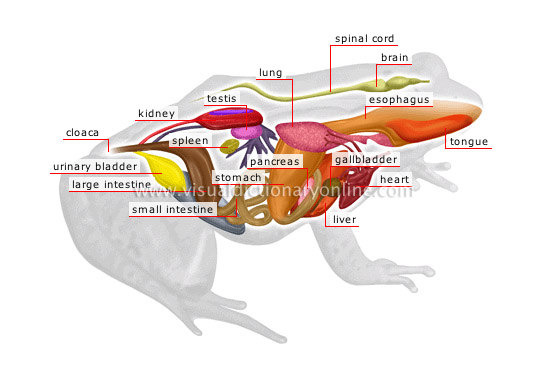anatomy of a male frog
spinal cord 
Component of the nervous system made up of a soft fatty substance and forming a cylindrical stem inside the vertebral column.
heart 
Muscular organ helping blood to circulate.
gallbladder 
Small reservoir in which bile secreted by the liver collects before being discharged into the intestine during digestion.
liver 
Gland secreting mostly a substance (bile) that contributes to digestion.
pancreas 
Digestive gland connected to the intestine that produces secretions and hormones.
stomach 
Dilated section of the digestive tract preceding the intestine; it receives food to be digested.
small intestine 
Long thin portion of the digestive tract behind the stomach in which most of the digestion and food absorption take place.
large intestine 
Short wide portion of the digestive tract preceding the cloaca in which a small part of digestion and elimination of waste take place.
urinary bladder 
Reservoir where urine from the kidneys collects before being evacuated by the cloaca.
cloaca 
Orifice common to the intestine and the genital and urinary tracts; it is located at the terminal end of the digestive tract.
spleen 
Organ of the circulatory system where impurities in the blood are destroyed.
kidney 
Organ secreting urine; it eliminates toxic substances from the body.
testis 
Male genital gland producing spermatozoa (sperm).
lung 
Respiratory organ made of an extensible tissue; it forms a sac into which air inhaled through the nostrils is carried. A frog also breathes through its skin.
brain 
Main organ of the nervous system consisting of nerve centers; it is located in the upper portion of the head.
esophagus 
Canal of the anterior portion of the digestive tract; it carries food to the stomach.
tongue 
Movable mouthpart having gustatory and prehensile functions.










